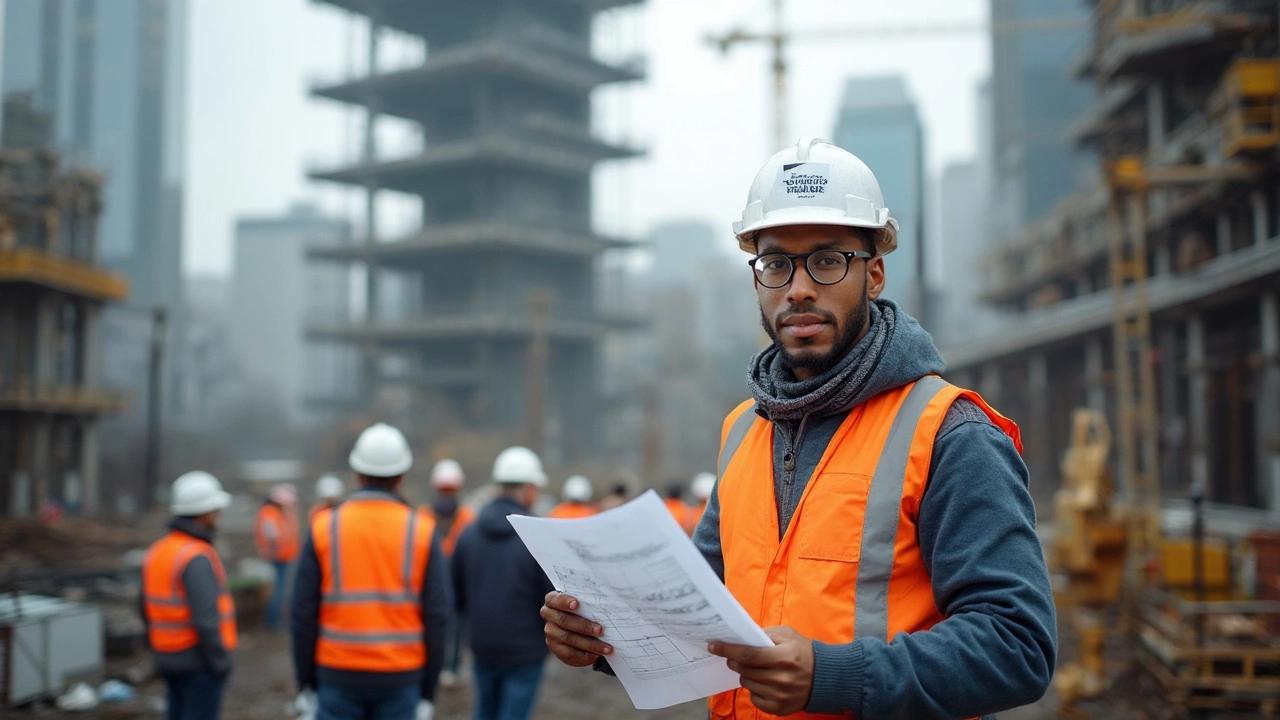Tier 1 Contractor Meaning: What Sets Them Apart in Construction Projects
 Jul, 1 2025
Jul, 1 2025
If you’ve ever walked past a giant city skyscraper or a sprawling hospital complex under construction and wondered who’s actually running the show, you’re asking about tier 1 contractors without even realizing it. People love talking about architects and designers, but the real engine under the hood of any big project? That’s your tier 1 contractor—these are the companies trusted with the biggest, most expensive builds out there. They’re everywhere you look in those crane-crowded skylines, yet not many can explain exactly what they do. Let’s clear that fog and see what really goes on behind the hoarding walls.
What Is a Tier 1 Contractor and How Are They Different?
Think of tier 1 contractors as the big players in construction. They’re the ones who take on projects so massive and complex that the average local builder wouldn’t know where to begin. But what exactly puts a company into this high-powered ‘tier 1’ bracket? It isn’t just a fancy title—it’s a sign of some serious trust and capability.
Tier 1 contractors bid for and deliver major projects, often for government bodies or big corporate clients. We’re talking airports, stadiums, city towers, motorways—if it’s got a billion-dollar price tag or a government stamp, odds are a tier 1 contractor’s involved. They’re called ‘main contractors’ in some regions, but ‘tier 1’ highlights the scale and complexity they handle compared to tier 2 or tier 3 players.
Some names you might recognize in this club? Think Balfour Beatty, Skanska, Vinci, Laing O’Rourke, and Dragados. These companies employ thousands, manage mind-boggling budgets, and juggle more moving parts than most imagine. To land these contracts, tier 1 firms prove a track record for quality, compliance, safety, and the muscle to pull everything off on time. Their fingerprints are on Olympic stadiums, bridges you cross every day, and even the high-speed rail lines connecting major cities.
Now, here’s where it gets interesting—they’re rarely the ones physically pouring the concrete or laying bricks. Instead, they manage an army of subcontractors, specialist suppliers, engineers, and sometimes, other contractors in the lower tiers. The tier 1 company sets the tone and standards for everyone else, making sure quality, budgets, timelines, and safety are all ticking along perfectly. Basically, if something goes wrong—a delay, a floor installed off-spec, or a safety mishap—the tier 1 contractor is on the hook, both legally and reputationally.
One myth is that tier 1 firms charge the highest prices simply because of their size. In reality, their deep supply chains and bulk buying power can create savings that ripple down. That’s why you’ll see them winning tenders for both public and private works—they often offer the best combination of reliability and price at scale.
Finally, if you ever spot news about a construction project with a mind-bending timeline or a “never been done” technical challenge, you can bet a tier 1 contractor is at the wheel. They’re the folks trusted to deliver the seemingly impossible.

The Role and Responsibilities of Tier 1 Contractors
So, what do tier 1 contractors actually do, day-to-day? Spoiler: they’re not just flicking through blueprints or shouting into walkie-talkies. Their real job looks a lot like first-class orchestration, where a single mistake could cost millions or even halt construction entirely.
It all starts at the tendering stage. Tier 1 contractors assemble expert teams just to bid for big jobs, often submitting proposals that run thousands of pages. They need to prove not only that they’re affordable but that they’re the lowest risk—nobody wants a half-finished airport. Once the contract is won, tier 1 firms get to work breaking down the giant project into manageable packages. Plumbing, electrical, steelwork, finishing—each piece is planned out, costed, and then sent out to specialist suppliers or tier 2/3 contractors for quotes.
Every decision at this level needs to balance risk, cost, and time. If a crucial supplier folds or a subcontractor delivers shoddy work, it’s the tier 1 firm on the hook. That’s why top-tier contractors run detailed background checks on everyone they work with and keep huge risk registers listing everything from labor shortages to bad weather. They plan for these hiccups before a shovel even hits the dirt.
Safety is another daily obsession. Tier 1 companies can’t afford a slip-up. The most reputable contractors go above and beyond minimum health and safety standards, using every new gadget—drones for inspection, AI for scheduling, even wearables for worker safety. Want to see a contractor lose a client fast? Let a serious safety problem hit the news. It rarely happens with top tier 1 firms because they invest heavily in training, audits, and on-site supervision.
Let’s talk numbers. On a complex site, project management software tracks thousands of tasks. Some tier 1 contracts can involve up to 100 separate subcontractors, with up to half a million man-hours on a single job. Below is a table with stats from recent major projects:
| Project | Tier 1 Contractor | Man-Hours | Subcontractors Involved | Completion Deadline |
|---|---|---|---|---|
| Crossrail (London) | BAM, Ferrovial, Kier JV | 30 million | over 80 | 2023 |
| Sydney Metro | CPB Contractors | 15 million | 60+ | 2024 |
| Heathrow T2 Expansion | Balfour Beatty | 20 million | 70+ | 2025 |
Every day, progress is tracked and reported back to the client, investors, and often to the public. When the project’s done, the tier 1 contractor doesn’t just walk away—they manage the handover, train the building’s operators, and guarantee defects are fixed under warranty. Their reputation hangs on every last detail.
If you’re chasing a career in construction and want to reach the top, landing a spot with a tier 1 contractor is a big deal. You’ll see the biggest projects, the trickiest technical challenges, and work under managers who’ve done it all before.
If you ever wondered why some buildings seem to rise overnight or how a team keeps a bustling train station open while adding three new platforms—you guessed it. There’s usually a tier 1 contractor quietly making the impossible look routine.

Why Tier 1 Contractors Matter and How To Spot One
So why does the world even need tier 1 contractors? At its core, these companies give governments and big businesses peace of mind they can’t get just anywhere. They take the insane web of tasks in a huge build—think 10,000 tons of steel, 5,000 workers, and regulations by the bucketful—and tame it into a smooth, safe operation. Without tier 1s, mega-projects would risk spiraling off the rails, bleeding cash and never finishing.
Spotting a tier 1 contractor isn’t rocket science—look for the ones getting awarded the contracts above $100 million or £80 million. They’re almost always members of trade associations like the UK’s Build UK or the US AGC (Associated General Contractors), and their logos pop up on infrastructure projects dominating the evening news. Tier 1s hold the certifications clients trust: ISO 9001 for quality, ISO 14001 for environment, and usually a stack of safety awards. Even smaller firms sometimes claim they’re 'tier 1,' but the real giants let their project lists do the talking.
Want to dig deeper? Check their annual turnover—most tier 1s handle over $1 billion a year and have a presence in several countries. They run their own advanced training academies, invest in green innovation, and some even have entire research divisions cooking up building techniques you won’t see anywhere else.
Here’s a quick cheat sheet of signs you’re looking at a real tier 1 contractor:
- Proven experience running massive projects above $100 million (£80 million)
- Mega-sized teams with hundreds or thousands of employees
- Long list of completed, recognizable infrastructure
- International operations and top-level certifications
- Deep pockets for research, new tech, and industry partnerships
Another thing that sets them apart: tier 1 contractors don’t just chase profit. They’re under public scrutiny to deliver safely, ethically, and sustainably. Many are judged on their environmental efforts and inclusivity—think Net Zero targets or backing apprenticeship programs for young trades.
Here’s a pro tip for anyone dealing with contractors for the first time: always ask for references of completed projects. True tier 1 players are proud to show off their track records. If a company offers you a huge discount but can’t show real history on jobs at scale, you’re better off walking away.
Interesting fact—some countries keep an official, government-approved list of tier 1 contractors eligible to win large public sector jobs. In the UK, for example, frameworks like the National Highways list cut the guesswork for clients. In the US, state DOTs (Departments of Transportation) maintain prequalified lists to quickly match mega-project needs with proven players.
And if you’re dreaming of working with or for a big-name firm, know that competition is stiff in this world. The pay’s good, the career ladders are steep, and the pace is relentless, but you’ll never learn more, or see bigger projects up close.
So next time you’re stuck in traffic near a giant construction site, remember: behind every banner draped over those fences is someone from a tier 1 firm, quietly keeping modern cities ticking, one impossible project at a time. That’s their claim to fame and responsibility—delivering the future, one super-sized job after another.
